History
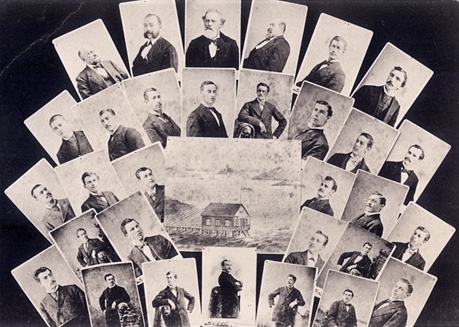
1877 – John Wieland and Valentine Kehrlein, Sr., immigrants from Germany, establish the Dolphin Swimming & Boating Club in August 1877. Six of their sons are among the twenty-five charter members, plus a few other honorary members. Emil A. Kehrlein becomes the first president of the new club.
1878 – The club builds a small boathouse and pier at the foot of Leavenworth Street, near the intersection of North Point Street, being SF Bay shoreline at the time.
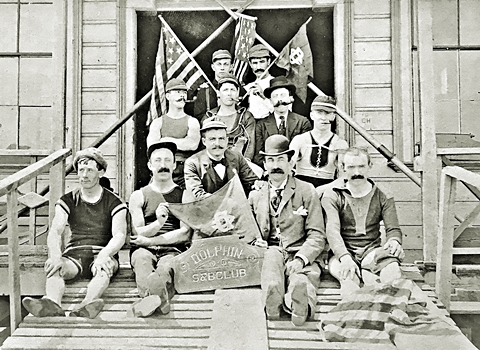
1879 – Dolphin Club rowers celebrate their first victory at a Pacific Amateur Rowing Association regatta.
1881 – Seven original members leave and then form the new Triton Rowing Club within a block from the Dolphin boathouse.
1887 – The club christens the John Wieland, a handsome forty-foot six-oared pleasure barge crafted by boatbuilder Al Rogers. It continues to be the pride of the fleet to this day.
1888 – The club incorporates under the laws of the State of California.
1892 – The club holds its first Hike & Dip, an annual event in late December of walking/running from the boathouse to Ocean Beach, taking a plunge in the cold surf, and then enjoying a luncheon at the Cliff House. The event, copied by a few clubs, lasts for 77 years.

1896 – Filling of the bay and the extension of Leavenworth Street force the club to vacate its boathouse. Member Adolph C. Lutgens, a noted architect, designs a new two-story clubhouse which is completed in 1896 at the foot of Van Ness Ave on Black Point Cove.
1897 – On October 17th John H. Caughlan, a Dolphin Club member, becomes the second person, the first local, to swim across the Golden Gate successfully.
1899 – Two Kehrlein brothers, former Dolphin charter members, operate the Hotel Nymphia, the most notorious brothel in San Francisco’s history.

1900 – Dolphin oarsman Alex Pape, undefeated in his first three years of racing shells, becomes the Pacific Coast Champion. The club membership limit is increased to fifty.
1903 – The Board approves replacing gaslights with electric. It will be three more years before they’re operating effectively.
1904 – The competitive rowing clubs unite to form the Pacific Association of Amateur Oarsmen (PAAO) with Dolphin Club’s Charles M. Farrell acting as temporary president. Another Dolphin, William F. Harris, is chosen to be the first president.
1906 – The Dolphin Club escapes the worst of the earthquake and fire. The club helps members financially and provides shelter to refugees. A baby girl is born at the club and named “Dolphine.” In appreciation, another boy is given the middle name of “Dolphin.” Following the earthquake, rubble is dumped in the Cove.

1908 – In late 1908 (or early 1909) the South End Rowing Club (SERC) joins the Dolphin Club at Black Point Cove. The SERC building is barged around from the foot of Third Street and placed west of the Dolphin Club. The Ariel Club builds a boathouse just east of the other two rowing clubs.
Life Membership status is established, and the first granted to Albert Rothkopf, a charter member of the club since 1877.
1909 – The Dolphin Club decides to add an initiation ceremony for new members at a picnic in Marin County. A somewhat silly ritual by today’s thinking, it continues until the 1960’s.

1910 – Space is increased by adding a thirty-foot extension onto the rear of the Dolphin Club building.
1911 – The Dolphin Board approves the addition of a handball court. The club now has 125 members.
1913 – To prepare for the upcoming Panama Pacific International Exposition, the State Belt Railroad builds a trestle directly across the Cove and over the rowing club piers to a new tunnel through Fort Mason. Somehow, the clubs cope and carry-on. By 1920 most of the trestle is dismantled, and tracks are on the shore of the Cove.

1915 – The California State Assembly approves the concept for Aquatic Park. Dolphin Charles M. Farrell is a force behind the project.
1917 – The Dolphin Club successfully holds its first club swim across the Golden Gate, the first by any organization. Twenty-three men finish.
Thomas Keenan, a club member and boatbuilder, delivers the Farrell, a Whitehall double still in excellent condition and popular with rowers.
The World War subdues club activities in the following years as some members serve in Europe.
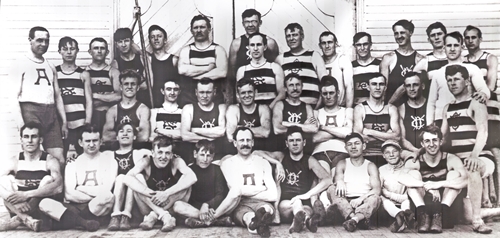
1918 – Despite the Spanish Flu Pandemic nearly all social and athletic activities are held as scheduled.
1923 – Southern Pacific builds the Hyde Street Pier. Charles M. Farrell is instrumental in getting the Pier built. Ferry boats take autos and passengers to Sausalito and Berkeley for years until the major bridges are opened.
The club builds a second handball court known as “Court B.”

1924 – Lawton Hughes becomes a Pacific Coast sculling Champion. In later years Lawton serves as the wise coach for many Dolphin Club crews.
1925 – Black Point Cove becomes the property of the City of San Francisco.

1927 – The Dolphin Club celebrates its 50th Anniversary. Membership is now 260, including 12 Life Memberships. To extend Van Ness Ave and build the Municipal Pier, the City relocates the three rowing clubs eastward to the beach area between Polk and Larkin Streets.
Les Hendry rows by himself from the Dolphin Club to Stockton. In 1956 Les and companions in a double row 105 miles to Sacramento. Ed de Cossio, Sr. with various partners will do it for twenty consecutive years. They establish a tradition of rows upriver that dozens of Dolphins have now completed and recall with pride.
1935 – The club dedicates its first Training Quarters for competitive rowers at Pier 54 in the China Basin area. Tom Troneum wins the Pacific Coast Singles Rowing Championship and continues winning major races through 1940.
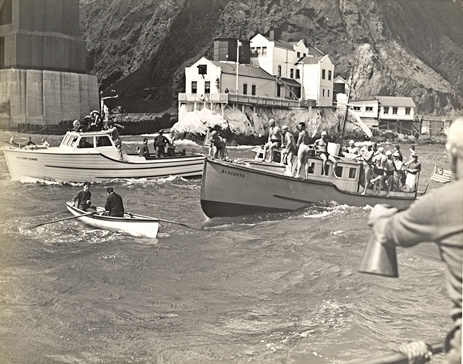
1937 – A teenage girl, Zada Weed, joins the mens-only Dolphin Golden Gate Swim and steals the publicity. Her coach is the famous Charlie Sava, a Dolphin Life Member. Years later in 1976, when finally allowed, Zada Weed Taft becomes one of the first women to join the Dolphin Club.
To complete the development of Aquatic Park, the three rowing clubs are jacked up and moved on rollers to their current lots on Jefferson Street. Up to this point, the clubs own their buildings and pay nothing to the City in rent. The City agrees to pay $3,800 for the cost of moving the clubs. In return, the clubs deed their buildings and sign tenancy agreements with the City.

1938 – Lawton Hughes buys a dozen large wooden chairs for the Staib Room lounge at $15 each. Big bright picture windows replace small old-fashioned ones.
Many old-timers and rowers, led by Lawton Hughes, are unhappy with windy conditions on the east side of Aquatic Park. Supposedly, the Park Commission agrees to find a better location for the clubs. The Dolphin Club will continually campaign, into the 1960’s, to have the club moved back to the west side of the Cove.
1939 – Aquatic Park is dedicated and opened to the public.

1940 – Sand excavated while building the Union Square garage is used to cover earthquake rubble, greatly improving the beach at Aquatic Park.
1941-1945 – Aquatic Park becomes military headquarters and a training area during WWII. More than a quarter of club members will serve in the military during the war.
1946 – The Board of Governors approve converting handball court “B” into a workshop to maintain the wooden boats.
The annual Golden Gate Swim is resumed after being on hold during the war years. Ex-GI Jack Reynolds returns to win his sixth straight despite the four-year layoff.
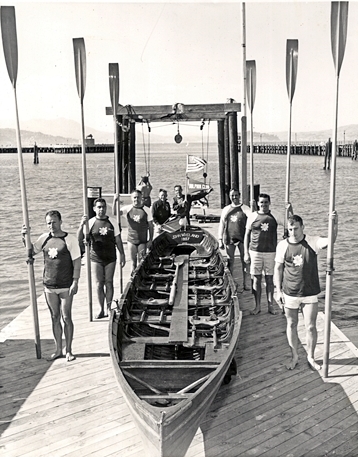
1948 – Using the new boatshop, Bill Richards builds three Whitehall singles, the Baggiani, Foster, and Landucci, that become the standard design of future club boats.
A separate dining room is constructed and named for Joseph Keenan whose generosity made the project possible. Some years later the space is transformed into the exercise/weight room.
Our neighbor the Ariel Club, founded in 1872, changes its name to the San Francisco Rowing Club.
1949 – The club magazine, Dolphin Log, makes its debut. Anita Day Hubbard becomes an honorary club member and is considered the first female member.
The barn-like walls of the main boathouse, entrance, and stairway are covered with “Driftwood” textured paneling. Also, a modern ceiling is installed and an orchestra pit (stage) is built.

1950 – A wide door is cut from the main boathouse into the “Court B” boat repair shop. The Aquatic Park Municipal Bathhouse is leased to the Maritime Museum Association.
1951 – The State Harbor Commission takes away our Training Quarters at Pier 54 for rail yard expansion. The City offers Lake Merced as a replacement. The Dolphin Club agrees and transfers training, however it will be 1956 before satisfactory facilities are dedicated at the Lake.
The Dolphin Club begins a series of membership drives by offering rewards for recruiting new men. These efforts continue until 1955.
1952 – It’s the club’s Diamond Jubilee, and Dolphin Club crews dominate the Pacific Association of Amateur Oarsmen regatta for the fifth year in a row. This would be the last PAAO regatta of importance before the association disbands in 1964. As a result, the PAAO Perpetual Challenge Shield honoring champion crews is still displayed in the Staib Room of the Dolphin Club.
The club initiates its very popular annual Raccoon Straits Swim which continues until replaced in 1967 with a Richardson’s Bay Swim.

1953 – The Fort Sutter, an old riverboat built in 1912, is pulled up next to the South End and the Dolphin Clubs. In 1959 it is burned to the waterline allegedly by disgruntled members of the South End Rowing Club.
The club participates in a Russian River Carnival. This annual “Row for Fun” along with some socializing, naturally, would last until 1966.
1954 – Membership dues are $25/yr. The club entertains youngsters from the Hanna Boys Center for a day of aquatic fun and food, a yearly event lasting for twenty years. The club hosts similar outings for the Big Brothers Organization during that period.
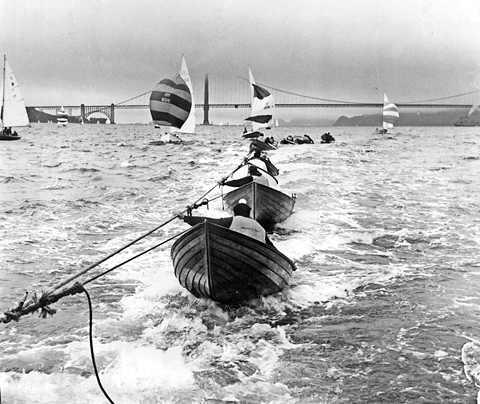
1956 – Jimmy Cronin, a member for 65 years, beloved by all, and the sparkplug of the club, passes away at age 89. A Whitehall double built in 1938 is named for him.
1958 – Membership at 300 now. The Crystal Plunge pool in North Beach, where Charlie Sava coached and other Dolphins perfected their strokes, is demolished to build apartments.
1960 – The Dolphin Club holds an Alcatraz swim, its first that becomes an annual event.

1962 – The club celebrates the 75th Anniversary of the John Wieland barge by rowing to Tiburon with major press and TV coverage. The honored crew consists of old-time oarsmen guided by coxswain Dr. A. W. Ward proudly wearing his 1905 rowing medal.
The club purchases a Pocock four-oared shell for $1250, the first new racing boat in several decades.
The handball court is shortened by six feet to AAU and USHA specifications.
1963 – An inattentive fishing boat hits Jim Small crossing from Sausalito with a few other Dolphin swimmers on Sunday, October 20th. Jim dies three days later at age 27.
The Dolphin Club sponsors and stages a successful Golden Gate Swim for 23 young ladies, the famous San Francisco Merionettes Synchronized Swim Team.

1965 – Notice: “Membership at Full Capacity. Applicants will be placed on a waiting list.” The club builds its first Sauna room which is available every day from 11 am to 7 pm.
Dolphin Club members Bob Farrell and Bill Sakovich, now in the Peace Corps, write interesting letters published in the Log. Years later, the UN recognizes Bill is as the “Father of Pacific Swimming.” Several Halls of Fame will honor Bill for advancing swimming in the remote Pacific.
1966 – Walt Stack organizes the Dolphin South End Runners Club (DSE) and serves as its first president. Walt encourages women, children, and all others to join the thriving DSE and enjoy running.

1967 – Dolphin member Lt. Colonel Stewart Evans swims from the Farallon Islands to Point Bolinas (north of San Francisco) becoming the first person to complete the crossing to the mainland. The swim of 20 miles begins at 10:17 PM on August 27th and finishes at 12:00 PM the next afternoon.
1968 – Dolphin and South End swimmers battle in a relay race from the Farallon Islands. The six-man Dolphin team wins in a time of 14 hours 54 minutes. It is still the only Farallones swim to come through the Golden Gate and finish on our beach at Aquatic Park.
The San Francisco Board of Supervisors declare the Farallones to San Francisco Swimming Association, affiliated with the Dolphin Club, to be the official organization regarding rules, regulations, standards, sanctions, and record keeping. They anticipate worldwide interest; however, it will be another forty years before anyone wants to attempt the swim.

1970 – The Constitution & By-Laws are revised allowing regular members to nominate and elect officers of the club. Previously, the Board of Governors would form a committee to nominate a slate of candidates. Rarely opposed, the Board would then approve the slate.
1972 – Elaine Pedersen, a DSE runner, is the second female to finish the Boston Marathon in the first year women are allowed to enter. She is also recognized for liberating the all-male Dipsea Race in 1966 and Bay to Breakers in 1967. In 1979 Elaine becomes one of the early female members of the Dolphin Club.

1973 – Lou Marcelli, who joined in 1965, becomes the club’s full-time caretaker, a position he will hold for forty years, attaining the beloved and respected title of “Commodore” of the Dolphin Club.
The first combined 2-club New Year’s Day Alcatraz Swim is a success, won by Dolphin Frank Blair.
The Dolphin Club hosts the first one-mile Cove swim open to outsiders and Masters known as the AAU Invitational. This popular race is held for thirteen years.
Although a few similar swims occurred earlier, the first Annual Santa Cruz Pier Rough Water Swim is held, supported by many enthusiastic Dolphins.
Mike Garibaldi wins his first Golden Gate Swim and will eventually set the current record of thirteen victories in the annual race.
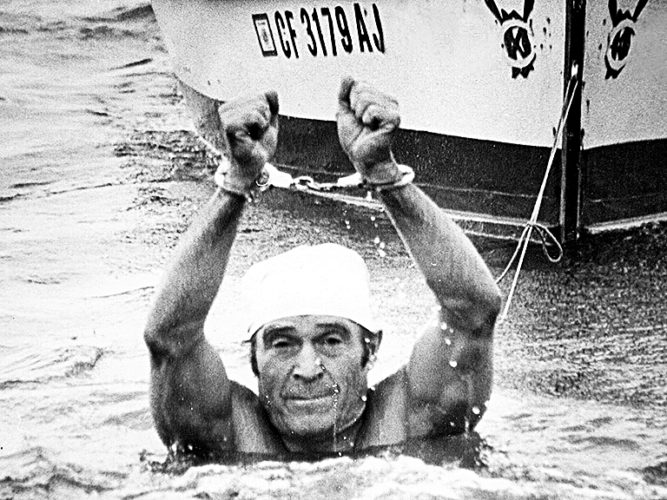
1974 – Honorary life member Jack LaLanne, shackled and manacled, tows a rowboat from Alcatraz to the club in less than ninety minutes.
Eleven senior club members participate in the first Over 60 Cove Swim.
The Polar Bear swim program originates in December 1974. The goal is for members to swim at least 18 miles during the three months of Winter. This goal is gradually increased to 40 miles. The record is 400 miles set by Duke Dahlin in 2016.
1975 – 1978 – The Golden Gate National Recreation Area (GGNRA), established in 1972, is gradually formed from an assortment of Bay Area parks and seashores. The State transfers its historic ships to the better funded federal government. The City transfers Aquatic Park in 1977, however the rowing clubs remain on city property.

1976 – As the outcome of successful litigation by six women, the rowing clubs begin accepting female members. Five women join the Dolphin Club in October 1976, and fifty in the following year.
The Dolphins and South Enders sign separate leases with the city. Each club’s lease is to run for an initial twenty-five-year period. The clubs manage daily operations and relieve the Recreation and Parks Department of this task while helping the City attain its mission of providing recreational opportunities for San Franciscans.
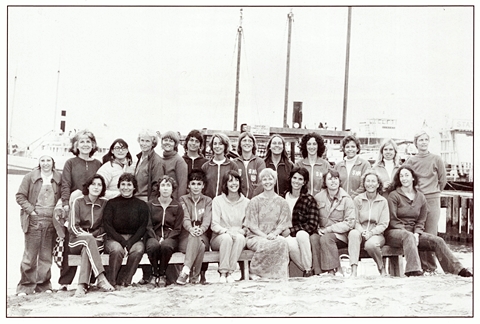
The Board selects Walt Schneebeli to be the official Club Historian. Walt will then sacrifice countless hours researching and collecting documents, photographs, and artifacts, as well as writing many Dolphin Log articles, until his passing in 2017.
A Bicentennial Tri-Sport (rowing, swimming, running) competition is held between the Dolphin and South End Clubs which will become the format of the annual DC/SE Triathlon.
1977 – The Dolphin Club has a rather quiet 100th Anniversary Celebration, likely due to ongoing changes, external and internal. Club membership now totals over 400 and is increasing rapidly due to the new women members, Masters Swimming, triathlons, wetsuits, and open-door policies.
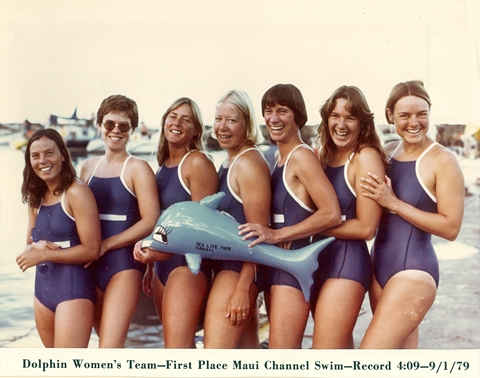
1978 – The first women’s locker room is opened thanks to the volunteer efforts of Herman Zahler. Although cramped, the space includes 62 lockers, toilets, shower room (4 heads), sauna, and costs $21,000.
The City evicts our neighbor, the San Francisco Rowing Club, for their refusal to admit women members and provide public access. The Dolphin Club reaches an agreement with the City to expand into the defunct property and make improvements.
Due to increased participation and safety concerns, the annual Golden Gate Swim is spread out over two days, a Saturday and Sunday. This schedule handles a peak of 138 swimmers in 1989 and lasts until 1999.
1979 – As required by their leases with the Rec and Park, both clubs begin paying the City 10 percent of gross revenues and all costs of operation, repair, and replacement.

Dolphin men’s and women’s relay teams dominate the annual Maui Channel swim in Hawaii. The Dolphin women will win the race five straight years before retiring.
1980 – Cynthia Ehrlich, the first female editor of the Dolphin Log in 1978, also becomes the first woman elected to the Board of Governors.
A fire, thought caused by transients, destroys the newly acquired SF Rowing Club building. The Dolphin Club is partially damaged, and a few photographs and records are lost, but the historic wooden boats are spared.
1981 – A fire sprinkler system, a project approved in 1979, is finally installed throughout the clubhouse.
The Dolphin Club stages the first annual Escape from Alcatraz Triathlon on July 11, 1981. Although much copied, it remains the most unique and challenging event.
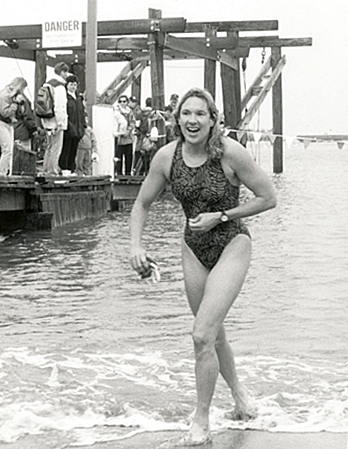
1982 – Frank Drum is elected club president for the final time having served 10 terms over a twenty-year span.
1983 – A January storm and eight-foot tides combine to severely damage the club pier and destroy the tanning and socializing area known as the Sand Pit. Repairs take months, and in 1984 the club constructs a seawall of short pilings circling the property.
1984 – Suzanne Heim is the first woman to win the New Year’s Day Alcatraz Swim.
Boatbuilder Jon Bielinski becomes a member and begins to rejuvenate and add to the club’s neglected fleet of wooden boats. He also organizes and teaches many volunteers in the craft of maintaining the valuable boats.
1985 – Suzanne Heim swims the English Channel. She repeats the feat two more times the next year and inspires others. Since then, over thirty Dolphins have crossed the English Channel.
The Army Corps of Engineers begins building the Hyde Street Breakwater. Swimmers and rowers tolerate the inconvenience and hazards for two years. When completed the breakwater helps to protect the rowing clubs from further damage by North wind and high waves.

1986 – The Dolphin Club dedicates a plaque at the Lake Merced naming the boathouse in honor of Tom Troneum.
1987 – Suzanne Heim wins the club’s Golden Gate Swim, becoming the first female champion. She goes on to win the Gate Swim ten times.
1988 – The membership elects Katie Maloney to be their first female club president.
The ship Balclutha arrives at Aquatic Park for permanent berthing at the Hyde Street Pier.

1989 – The Loma Prieta earthquake jolts the club. The most visible damage is to historic photographs that fall off the walls and break, some never repaired. As soon as time permits, the club’s building and foundation are strengthened to code.
Six Dolphins become the first all-female USA relay team to swim the English Channel.
1991 – After ten years of plans, permits, and work following the fire of 1980, the Dolphin Club dedicates its new Annex in Spring 1991. The Annex includes the now women’s locker room, the Sancimino room, Zahler boathouse, driveway and shed for power boats.
The SF Recreation and Parks Commission approves our Dolphin Club’s Open Access Policy.
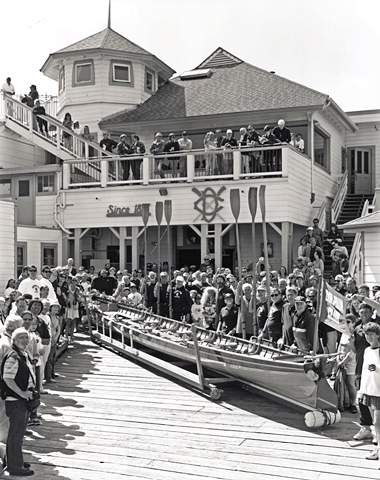
1993 – At age 80 Joe Bruno completes his 61st and final Golden Gate crossing. The club names its annual event the “Joe Bruno Golden Gate Swim.”
1997 – Fully refurbished to new condition, the John Wieland is relaunched at a large and joyous celebration.
Life Member Dr. Stanley B. Prusiner, a regular rower at the Lake, is awarded the Nobel Prize in Medicine.
The annual Ladies Lunch tradition is established to honor women with twenty or more years of membership.
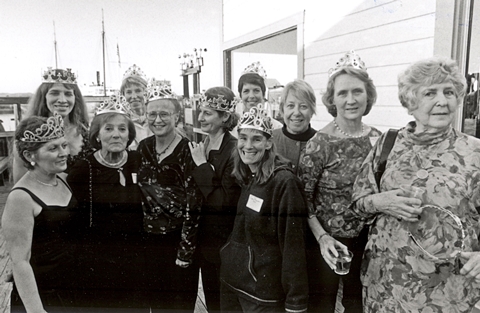
1998 – The Dolphin Club website is posted online.
1999 – The Dolphin Club renews a 24-year lease with the City of San Francisco.
2000 – The club now has 900 members. Dolphin Sebastian Bea and rowing partner Ted Murphy win Silver at the Sydney Olympic Games in the coxless pair event.
2002 – The Dolphin Club celebrates its 125th anniversary and first class of female 25-year Life Members.
2006 – Dolphin Renee de Cossio rows single handedly the 90 nautical miles from the club to Sacramento, the first known woman to accomplish this long upriver pull.
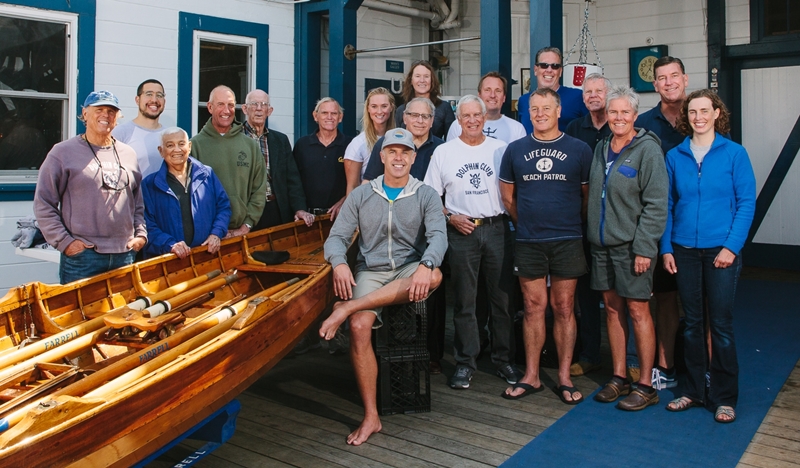
2014 – Dolphin Joe Locke swims from the Farallon Islands to the Golden Gate Bridge in 13 hours and 58 minutes becoming the first to achieve this since Ted Erikson in 1967. Dolphin Kimberley Chambers crosses the North Channel becoming the sixth person worldwide to complete the Oceans Seven Challenge.
Racheal Perry and Kelly Amdur win their 2X rowing race in the elite Head of the Charles Regatta in Cambridge, MA.
Also in 2014, the Archives Project is established to collect and catalog all special records, historical photographs, and club artifacts. The purpose is to formally inventory what the club has and where items are displayed or stored. Preservation is a high priority. Beginning in 2019 a commercial cloud-based system, CatalogIt, is used by the archiving team to store and manage our club data. CatalogIt also provides limited online browsing for all club members.
2015 – Kim Chambers swims from the Farallones to the Golden Gate Bridge, the first woman to finish this challenging 30-mile ocean swim.
2016 – Club membership grows to 1500.
2017 – Catherine Breed swims the length of Tahoe in the fastest time ever recorded: 8 hours 56 minutes.
The Dolphin Club celebrates the 100th Anniversary of its annual Golden Gate Swim. Many old timers and champions return to be honored. Dignitaries also attend and praise the club for its historic accomplishments. The wooden double, Farrell, is also honored as participating in both swims a century apart.
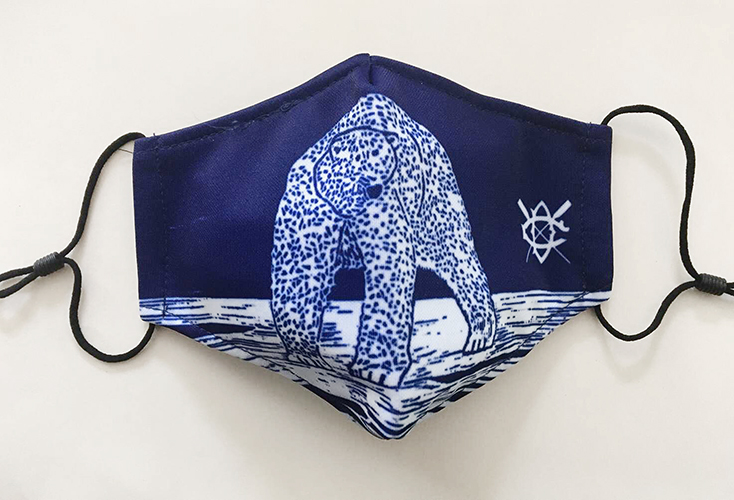
2019 – The IRS grants 501(c)(3) charitable status to the newly established Dolphin Swimming and Boating Foundation. Donations must be for improving our building, providing public access, or supporting educational programs offered to the public.
A project is launched to renovate major sections of the clubhouse. With many permits required and then construction, it is expected to take several years to achieve. Private fund raising is the first step with a goal of 2.75 million dollars.
2020–2021 – The COVID-19 pandemic shelter-in-place severely impacts the club. Restrictions begin in March 2020 with members locked out of the clubhouse, and monthly Board Meetings are conducted remotely online. Dolphins display their versatility by swimming off the Aquatic Park bleachers and other public beaches. Beginning in May 2020, swimming is again allowed off the club deck and beach but limited to a small group of members at one time. Still, they are not allowed to use lockers, showers, and saunas inside the building. It’s a year later when the boathouse is cautiously reopened to vaccinated members. On July 18, 2021, scheduled club group swims resume with a Pier 39 swim.
2022 – In September the Board of Governors convene in-person for the first time in over two years when the COVID-19 shelter-in-place began.
The Dolphin Club signs a new lease with the city for 25 years with an option of 24 years thereafter.
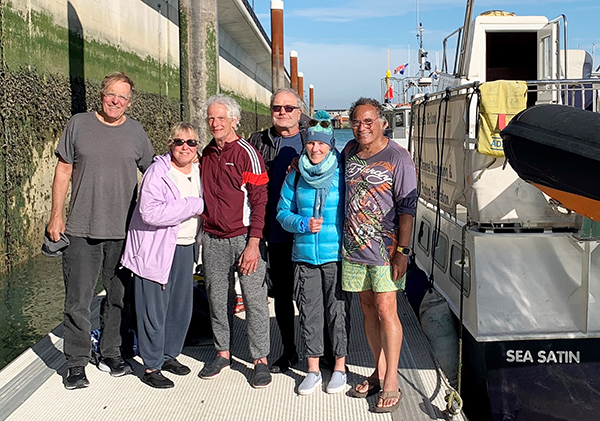
2023 – Club growth reaches 2000 including 386 Life Members (25 or more years).
A relay team of six Dolphin Club Members, all over the age of 70, swim the English Channel in 15 hours and 10 minutes. With an average age of 73.2 years, they are the oldest American team in history to cross the Channel.
2025 – In April, Dolphin Ryan Utsumi completes the crossing from Spain to Morocco to become the 35th person in history to achieve the Oceans Seven Challenge. Ryan’s O7 journey began in 2016 with an English Channel Swim.
Catherine Breed swims from the Farallon Islands to the Golden Gate Bridge in record time. She is the fourth Dolphin and only the seventh person to complete this swim.
Sunny McKee is honored as a World Champion triathlete by winning her age group in the Ironman World Championship in Hawaii
After five years of planning, designing, and fundraising, construction begins in August to pour a foundation, rebuild the club’s weight room and galley, install a new elevator, repurpose old office space, and build a co-ed sauna. The project is expected to take eight months.
